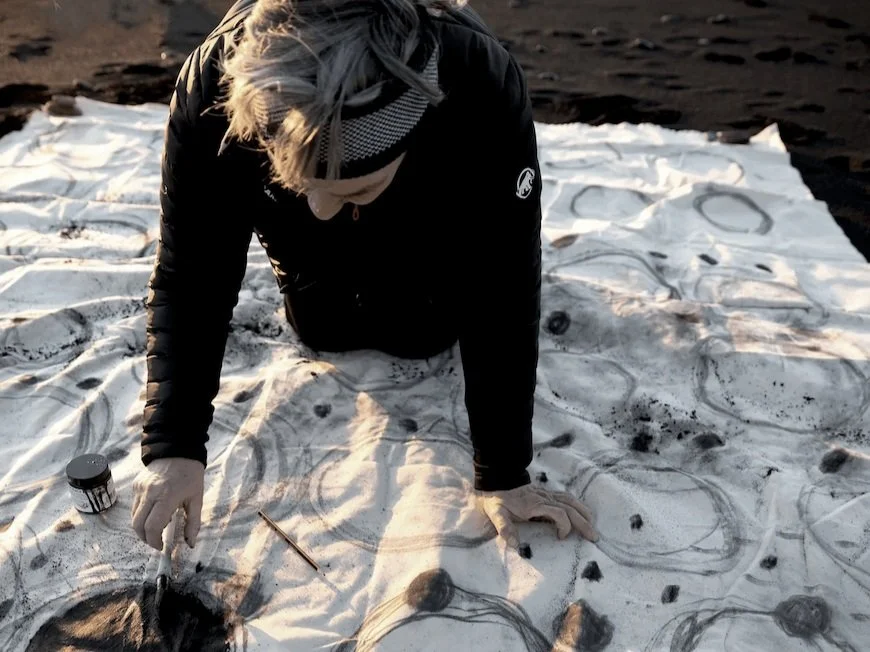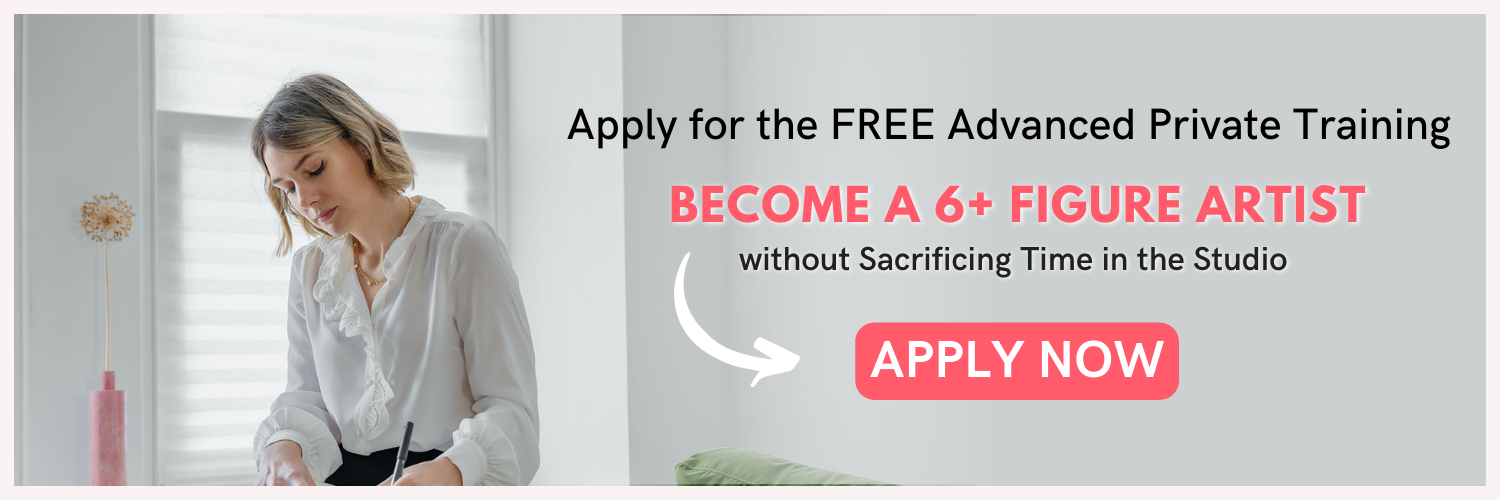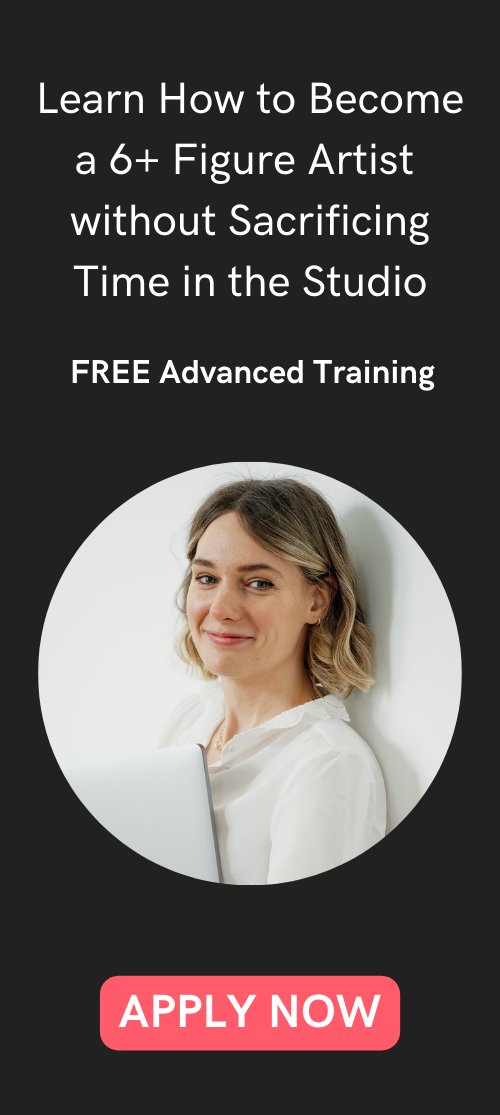How to Write an Artist Statement (with Examples)
As a professional artist, having a clear artist statement on your website is incredibly important. Why? Well because it allows potential art buyers and even galleries to clearly understand what your work is all about and who you are as the artist behind it.
Think of your artist statement as a guide that gives any website visitor a peak inside of your mind to get a better understanding on you and your work. It helps them understand the inspiration, the emotion, and intention behind your art works. An artist statement serves as the bridge between your creative vision and the viewer’s understanding. It’s a powerful tool that enables you to communicate your thoughts, motivations, and the essence of your work.
In this blog post, I’m sharing my top tips on how to write an effective artist statement that captivates your audience and opens the doors to your artistic vision.
Understand the purpose behind your art
An artist statement is more than just a description; it's a glimpse into your mind. Before putting pen to paper, take some time to contemplate why you create the work that you make. Is it to express your emotions? Challenge societal norms? Or evoke certain feelings in your audience? Understanding the purpose behind your work will help you infuse your statement with authenticity and clarity. Before you start writing, it's crucial to really dive deep on this and have an understanding first before attempting to articulate it with your audience. Here are a few tips that will help you go that bit deeper and help you craft an effective artist statement:
Reflect on Your Artistic Journey: Your artist statement is your chance to tell the world what drives you to create. Are you hoping to evoke nostalgia, is it a mediative process for you, or is your intention to simply share the beauty you see in the world? Jot down the emotions, ideas, or experiences that drive your creative process. When you understand your intentions, you can express them clearly in your statement.
Identify Common Themes: Look for recurring elements in your artwork. Is there a consistent theme, style, or subject matter? These can provide valuable insights into your purpose.
Ask Yourself 'Why': Challenge yourself with the question, "Why do I create?" Keep digging deeper until you unearth the core motivations.
Craft a Clear Purpose Statement: Summarise your purpose in a sentence or two. This concise statement will serve as the foundation for your artist statement.
By understanding the purpose behind your art, you open doors to create a deeper connection with your audience.
Know your audience
Consider who will be reading your artist statement. Are they art enthusiasts, collectors, galleries, or the general public? Tailor your statement to resonate with your intended audience while still staying true to your artistic voice. To craft an engaging artist statement, you must know your audience. My main tips to help you understand your audience as an artist are:
Identify your audience segments and tailor your voice to them: List the various groups of people who might engage with your art—artists, galleries, collectors, art lovers, etc. Different audiences resonate with different tones. If you're addressing galleries, you might delve into technical aspects. On the other hand, if you’re speaking to a broader audience of art collectors, you'd want to emphasise relatable emotions and themes.
Engage with art collectors: Consider adding insights into your creative process, inspirations, and the evolution of your work. Collectors often seek to understand the artist's journey, adding a layer of value to the art they acquire.
Create a deeper connection: By knowing your audience, you're showing them that you care about their experience. This understanding builds empathy and fosters a stronger connection between your art and their emotions.
Use an active voice: Use the first person throughout your artist statement as it will allow you to connect with your audience on a deeper level.
Adapt over time: As you learn more about your audience through interactions and feedback, adjust your artist statement accordingly to maintain that strong connection.
Understanding your audience transforms your artist statement from a one-size-fits-all description into a personalised invitation. It's your way of saying, "I know you, and I want to share my art with you in a way that resonates." This understanding lays the foundation for a more profound and lasting connection between your work and the people who experience it.
Keep it clear and concise
A well-crafted artist statement is succinct yet impactful. Aim for a length of around 150 to 250 words. Especially since nowadays, people don’t have the time or attention span to read through a lengthy piece of text. By being concise you’re making sure your message doesn’t get lost.
Avoid (art) jargon or overly complex language that might alienate your readers. In my art world career, I read though hundreds of artist statements and although I studied art and art history and was a gallerist, many of the statements I would read were very difficult to understand and relate to. There is a common misconception that artist statements must sound “academic” – this is not a good approach when writing your artist statement. Your goal is to foster a connection and understanding between your work and your audience. To do this, you should aim to use clear and accessible language that anyone can grasp. When your message is clear, readers can connect more easily with you and your work.
Overall, an artist statement should be focused on telling the reader/potential art buyer what they need to know about you and your art work in a simple and concise way.
Remember to update your artist statement regularly
Your artist statement is a dynamic reflection of your artistic journey. Just as you evolve as an artist, your statement should evolve too. Your artist statement should mirror your growth and capture your latest perspectives.
It is not only a good way to keep your website updated, but the process of updating your statement prompts you to reflect on your art's meaning and purpose. This self-examination can lead to new insights.
Plus, while having a main artist statement is definitely important, you’ll likely want to update it depending on where you’re sharing it. Whether that is exhibitions, galleries, or different collaborations. So not only should you update your main artist statement regularly, but you should also check and update it if needed every time you’re sharing it on different platforms.
Tip: Determine how often you’d like to revisit your artist statement. Consider doing this at least once a year or whenever you experience a significant shift in your artist journey.
Regularly updating your artist statement ensures it remains a true representation of your evolving creative self and helps you connect more authentically with your audience and any opportunities that come your way.
In a nutshell, the top four aspects of crafting an engaging artist statement are, understanding the purpose behind your art, knowing your audience, keeping it clear and concise, and keeping it updated as you evolve as an artist.
Once you’ve created an impressive artist statement, it’s time to share your big vision with the world so you can increase your revenue and impact. And that’s exactly what I teach inside the Artist Accelerator Mastermind. This is a special space for fine artists who have big dreams for their lives and art businesses and aren’t afraid to invest in the right support to help them get there.
It’s perfect for you if you’re determined and motivated to change your reality, create more freedom—both time and financial—create more wealth, and worry less by outsourcing social media marketing and smaller day-to-day tasks in your art business. You’re ultimately ready to evolve into your next level in business and in yourself. Once you have all the knowledge on how to grow a sustainable art business, you’ll be able to start taking aligned and thought-out action that actually generates results!
Here are some examples of amazing artist statements written by my clients:
Elizabeth Barlow’s Artist Statement: https://www.elizabethbarlowart.com/artist-statement
Mary Little’s Artist Statement: https://www.marylittle.com/bio
Helen Booth’s Artist Statement: https://www.helenbooth.com/about/
Want to become a 6+ figure artist? Apply below 👇
RESOURCES:
✅ Artist Accelerator Mastermind: https://marthamayronson.com/aa-application-ev
✅ Sell Your Art Online: http://sellyourartonline.co
✅ Instagram for Artists: https://marthamayronson.com/ifa
✅ Pricing Your Art: https://marthamayronson.com/pya
✅ Be Your Own Gallerist: https://marthamayronson.com/byog
FOLLOW MARTHA ON OTHER PLATFORMS:
🌟 Instagram: https://instagram.com/marthamay
🌟 Twitter: https://twitter.com/_marthamay
🌟 LinkedIn: https://www.linkedin.com/in/marthamayronson
🌟 YouTube: https://www.youtube.com/@marthamayronson
MORE FROM MARTHA:
➡️ Download my FREE A-Z Gallery Jargon Explained Guide: https://marthamayronson.com/gallery-jargon
➡️ Download the FREE 50 Email Subject Lines for Fine Artists: https://marthamayronson.com/subjectlines
➡️ Download my FREE Ultimate Online Art Business Checklist: https://marthamayronson.com/art-business-checklist
➡️ Download my FREE Ultimate Guide to Selling Your Art on Instagram: https://marthamayronson.com/instagram-guide
If you know someone who would benefit from reading this post, please feel free to share and help others! If you are an Artist and have a burning question about the Art World or Art Business and would like it answered in a blog post, you can email me here hello@marthamayronson.com.






